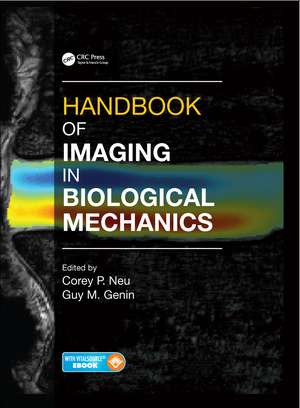Handbook of Imaging in Biological Mechanics
Editat de Corey P. Neu, Guy M. Geninen Limba Engleză Hardback – 24 oct 2014
The Handbook of Imaging in Biological Mechanics presents the spectrum of imaging techniques used for noninvasive visualization of the morphology and mechanics of the large and small—from organs to individual macromolecules.
The handbook presents optimal imaging technologies to study deformation, stress, and constitutive behavior of tissues, cells, and proteins. It also describes a suite of technologies available for probing the mechanics of surfaces, membranes, and single molecules. With chapters authored by highly recognized experts in their area, the handbook covers the entire spectrum of biomechanical and mechanobiologic imaging technologies available today.
Preț: 1011.80 lei
Preț vechi: 1343.45 lei
-25% Nou
Puncte Express: 1518
Preț estimativ în valută:
193.60€ • 202.68$ • 160.20£
193.60€ • 202.68$ • 160.20£
Comandă specială
Livrare economică 15-29 martie
Doresc să fiu notificat când acest titlu va fi disponibil:
Se trimite...
Preluare comenzi: 021 569.72.76
Specificații
ISBN-13: 9781466588134
ISBN-10: 1466588136
Pagini: 579
Ilustrații: 421
Dimensiuni: 210 x 280 x 30 mm
Greutate: 1.84 kg
Ediția:1
Editura: CRC Press
Colecția CRC Press
ISBN-10: 1466588136
Pagini: 579
Ilustrații: 421
Dimensiuni: 210 x 280 x 30 mm
Greutate: 1.84 kg
Ediția:1
Editura: CRC Press
Colecția CRC Press
Cuprins
Introduction. Tissue and Organ Imaging Methods: Magnetic Resonance Imaging Methods. Tissue and Organ Imaging Methods: Ultrasound. Tissue and Organ Imaging Methods: Radiography and Computed Tomography. Tissue and Organ Imaging Methods: High Throughput and Image Quantification. Tissue and Organ Imaging Methods: Multiscale Imaging and Modeling. Cellular and Molecular Imaging Methods: Microenvironments: Native ECM. Cellular and Molecular Imaging Methods: Microenvironments: In Vitro Culture Systems. Cellular and Molecular Imaging Methods: Cellular and Subcellular Biophysics. Cellular and Molecular Imaging Methods: Nuclear Biophysics. Cellular and Molecular Imaging Methods: Channels. Cellular and Molecular Imaging Methods: Surfaces and Single Molecule Measurements.
Notă biografică
Corey Neu directs the Soft Tissue Bioengineering Laboratory at Purdue University and holds an appointment on the faculty in Purdue’s Weldon School of Biomedical Engineering. He earned a PhD in biomedical engineering from the University of California, Davis. Dr. Neu studies force transfer in cells and tissues in the context of disease and regeneration. His current research focuses on structural and mechanical changes to articular cartilage in the pathogenesis of osteoarthritis, and multiscale biomechanics and mechanobiology of collagen-rich tissues.
Guy Genin holds appointments on the faculty of the Department of Mechanical Engineering and Materials Science at Washington University in St. Louis, and the Department of Neurosurgery at the Washington University School of Medicine. Dr. Genin earned his PhD in applied and solid mechanics from Harvard University. He studies interfaces and adhesion in nature, physiology, and engineering. He is the recipient of numerous awards for engineering design, teaching, and research, including a Research Career Award from the National Institutes of Health and the Skalak Award from the American Society of Mechanical Engineers.
Guy Genin holds appointments on the faculty of the Department of Mechanical Engineering and Materials Science at Washington University in St. Louis, and the Department of Neurosurgery at the Washington University School of Medicine. Dr. Genin earned his PhD in applied and solid mechanics from Harvard University. He studies interfaces and adhesion in nature, physiology, and engineering. He is the recipient of numerous awards for engineering design, teaching, and research, including a Research Career Award from the National Institutes of Health and the Skalak Award from the American Society of Mechanical Engineers.
Descriere
Transformative technologies such as microCT scans, super-resolution microscopy, fluorescence fluctuation analysis, and other methods now allow us to study the mechanics of cancer, dissect the origins of cellular force regulation, and examine biological specimens at the nanoscale. This handbook presents the spectrum of imaging techniques used for noninvasive visualization of the morphology and mechanics of the large and small—from organs to individual macromolecules. It discusses the selection and application of imaging technologies to study deformation, stress, and constitutive behavior of tissues, cells, and proteins.
